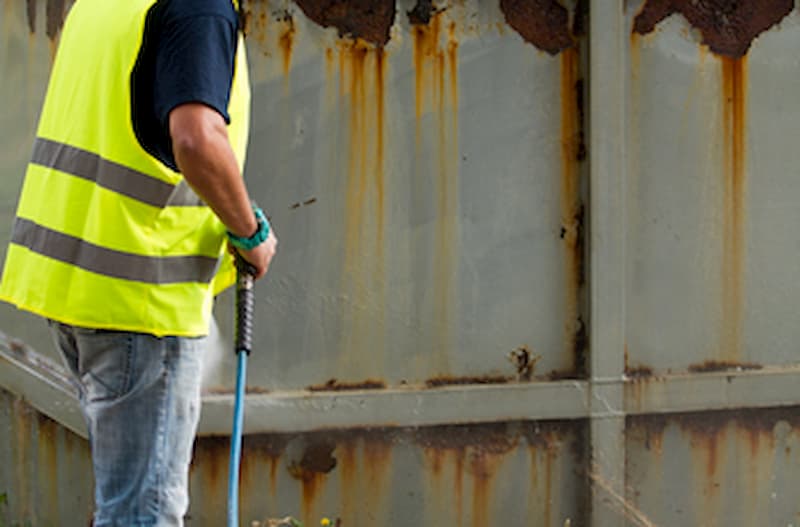
Rust stains are among the most stubborn and unsightly marks you can find on outdoor surfaces. Whether they come from patio furniture legs, sprinkler systems, metal handrails, or even fertilizers, rust stains tend to bleed into concrete, pavers, bricks, and siding, creating orange or brown discoloration that seems impossible to remove. Luckily, with the right power washing techniques, you can eliminate these stains safely and effectively.
This guide covers everything you need to know to power wash away rust without damaging your surfaces—and without harsh chemicals that could harm your landscaping 🌿🚿.
🧪 What Causes Rust Stains Outside?
Rust occurs when iron or metal oxidizes, usually from moisture exposure. Common outdoor sources include:
- Metal patio furniture or grills
- Sprinkler systems hitting concrete or siding
- Leaky water spigots or hose attachments
- Metal plant stands or fencing
- Fertilizers with high iron content
- Nails or fasteners embedded in walls or decks
When water interacts with these elements, it carries iron particles into porous materials like concrete or brick, leaving behind reddish-orange stains.
⚠️ Why Rust Stains Are Tricky
Rust stains penetrate deeply into porous surfaces. If left untreated, they can:
- Permanently discolor concrete or pavers
- Weaken structural material over time
- Cause pitting in bricks or stone
- Ruin your home’s curb appeal 🏡
And because they’re oxidation-based, regular soap and water won’t cut it. That’s where smart power washing comes in.
✅ Tools and Supplies You’ll Need
- Pressure washer (2,500–3,000 PSI ideal)
- 25° or 15° nozzle tip
- Rust remover or oxalic acid-based cleaner
- Pump sprayer or brush (for applying cleaner)
- Eye protection 👓 and gloves 🧤
- Garden hose for pre- and post-rinse
- Optional: plastic sheeting to protect nearby plants
Browse Amazon Here For Top Rated Power Washers And Accessories
🧼 Step-by-Step: How to Power Wash Rust Stains
1. Pre-Treat the Area
Before you even start pressure washing:
- Sweep away loose dirt and debris
- Lightly wet the surface with a hose
- Apply a rust remover solution according to the label
- Look for one that is oxalic acid-based
- Avoid bleach—it can set the stain or damage nearby plants
- Let it sit for 10–15 minutes, but don’t let it dry out
💡 Pro tip: Apply using a pump sprayer for even coverage.
2. Scrub if Needed
For deep or old rust stains, use a soft-bristle brush to agitate the cleaner into the surface. This helps lift particles before rinsing. Avoid using metal brushes—they may scratch or worsen the staining.
3. Pressure Wash the Area
Set your pressure washer with a 15° or 25° nozzle, then:
- Keep the tip 6–12 inches away from the surface
- Use slow, overlapping passes
- Angle the spray to avoid streaks or gouges
- Repeat 2–3 times if necessary
Be especially careful on painted or sealed surfaces—use lower pressure if needed to avoid stripping paint.
4. Rinse Thoroughly
After the rust lifts:
- Rinse with clean water using the pressure washer or garden hose
- Ensure no chemical residue remains
- Direct runoff away from lawns, flower beds, or drains
Let the area dry fully before determining if a second application is necessary.
🧠 Additional Tips for Rust Removal
- For concrete: Oxalic acid-based cleaners are most effective
- For brick or stone: Use a product marked “safe for masonry”
- For siding: Spot-treat only and use lower pressure
- Avoid letting rust form by placing rubber pads under furniture legs
- Seal your concrete after cleaning to prevent future staining
❌ Common Mistakes to Avoid
- ❌ Using bleach – it can react with iron and worsen staining
- ❌ Spraying too close – can etch softer materials
- ❌ Not rinsing thoroughly – leftover cleaner can discolor the area
- ❌ Skipping PPE – rust removers are acidic and can irritate skin or eyes
- ❌ Ignoring runoff – protect plants and grass with barriers or tarps
🌿 Eco-Friendly Cleaning Options
If you prefer a greener method, try this DIY paste:
- 1/2 cup baking soda
- 1/4 cup white vinegar
- Apply paste to the stain
- Let sit for 30 minutes
- Scrub and rinse
- Follow up with low-pressure washing
It won’t be as powerful as chemical cleaners, but it can reduce mild stains without harming the environment 🌍.
🔁 How Often Should You Do This?
- Treat rust stains as soon as you notice them
- Annual maintenance power washes help prevent buildup
- Reapply sealer to concrete every 2–3 years to reduce stain absorption
💬 Final Thoughts
Rust stains don’t have to be permanent. With the right cleaner, nozzle, and technique, you can restore your outdoor surfaces to their original brightness without resorting to heavy chemicals or scrubbing for hours.
By combining a solid rust remover with thoughtful power washing, you’ll save yourself time, protect your surfaces, and boost your curb appeal in one go 🔧🧼🏡.
Browse Amazon Here For Top Rated Power Washers And Accessories



